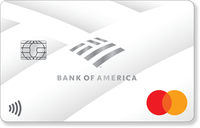BankAmericard vs. Wells Fargo Reflect Card

Key takeaways
- The BankAmericard® credit card and the Wells Fargo Reflect® Card are both good options for those looking for a low intro APR credit card with a lengthy introductory period.
- The BankAmericard credit card has a lower balance transfer fee than the Wells Fargo Reflect Card, but it also has a slightly shorter introductory period.
- Neither card offers a welcome bonus or rewards, but the Wells Fargo Reflect Card can earn cash back for the cardholder’s My Wells Fargo Deals account.
An introductory APR credit card can help you temporarily curb interest on new purchases and current credit card debt. Several different cards offer interest-free periods on purchases and balance transfers, so it can be hard to choose the right one. However, two options worth looking into are BankAmericard® credit card* and the Wells Fargo Reflect® Card. Both cards carry comparable benefits, but each has a distinct advantage over the other — depending on your needs.
Main details
Both cards offer similar 0 percent introductory periods and don’t charge annual fees. These factors combined make these cards worthwhile for cutting down interest, but the right one for you will depend on how you strategize your card use and debt management. When you compare both cards, the differences between their ongoing APRs, balance transfer fees and introductory periods set these cards apart from one another.
| BankAmericard® credit card | Wells Fargo Reflect® Card | |
|---|---|---|
| Welcome bonus | N/A | N/A |
| Rewards rate | None | None |
| Intro APR |
|
|
| Regular APR | 16.24%–26.24% variable |
17.24%, 23.74%, or 28.99% Variable APR |
| Balance transfer fee | A 3% Intro balance transfer fee will apply for the first 60 days your account is open. After the Intro balance transfer fee offer ends, the fee for future balance transfers is 4%. | 5% or minimum $5 fee |
| Annual fee | $0 | $0 |
| Perks | BankAmeriDealsMuseums on Us | Cellphone protection24/7 roadside dispatch assistanceMy Wells Fargo Deals |
BankAmericard and Wells Fargo Reflect Card highlights

Wells Fargo Reflect® Card

BankAmericard® credit card

BankAmericard® credit card
Tie
Which balance transfer card saves the most money?
Both the BankAmericard and Wells Fargo Reflect offer lengthy intro APR periods on balance transfers, but how much you save with either card will depend on how much you plan to transfer, how you intend to pay back the debt and how quickly you plan to do so.
BankAmericard vs. Wells Fargo Reflect Card balance transfer example
Let’s compare transferring a $3,000 balance to either card using our credit card balance transfer calculator.
| Card name | Balance | Transfer fee | Monthly payment | Total paid |
|---|---|---|---|---|
| Wells Fargo Reflect Card | $3,000 | $150 (5% in the first 120 days) | $150 for 21 months | $3,150 |
| BankAmericard | $3,000 | $90 (3% in the first 60 days) | $172 for 18 months | $3,090 |
The Wells Fargo Reflect Card costs a little more overall than the BankAmericard due to the balance transfer fee, but it also gives you a lower monthly payment and more time to pay off your balance before the intro APR period is over.
You’ll need to determine if a higher monthly fee fits into your budget. If it can, the BankAmericard will be the more affordable, long-term option for a balance transfer.
Why you should get the BankAmericard
The BankAmericard is a great fit for people managing debt who want to make it an affordable, long-term endeavor that doesn’t tack on a substantial fee. If you’re focusing solely on reducing your debt, you won’t risk adding a lot more to your current balance and you’ll have access to a fairly low ongoing APR beyond your intro period. Here are some other benefits to consider if you’re thinking about getting the card:
Why you should get the Wells Fargo Reflect Card?
If you’re managing debt but still want your credit card to carry a perk that brings value to your wallet, the Wells Fargo Reflect can be a great choice for you. Here are some additional benefits that could make the card worth getting:
The bottom line
Neither card offers the perks and benefits of rewards credit cards that offer intro APR periods on purchases, balance transfers or both — but both the BankAmericard and Wells Fargo Reflect are still worthwhile options to consider if you want to focus all of your efforts on debt management without the distraction of rewards.
Since these cards are very similar, your preferences as a cardholder should take precedence when deciding between them. The BankAmericard might be right for you if you’re looking for a lower ongoing balance transfer fee and the possibility of a lower APR rate, whereas the Wells Fargo Reflect may be right for you if you value having cardholder perks and lower monthly payments over a longer intro APR period.
We recommend reading our reviews for both the BankAmericard and the Wells Fargo Reflect card. Our team of experts provides thorough analyses of card details that can help you decide on the best card for you.
*Information about the BankAmericard® credit card has been collected independently by Bankrate. Card details have not been reviewed or approved by the card issuer.
The Bank of America content in this post was last updated on October 9, 2024.
Why we ask for feedback Your feedback helps us improve our content and services. It takes less than a minute to complete.
Your responses are anonymous and will only be used for improving our website.






